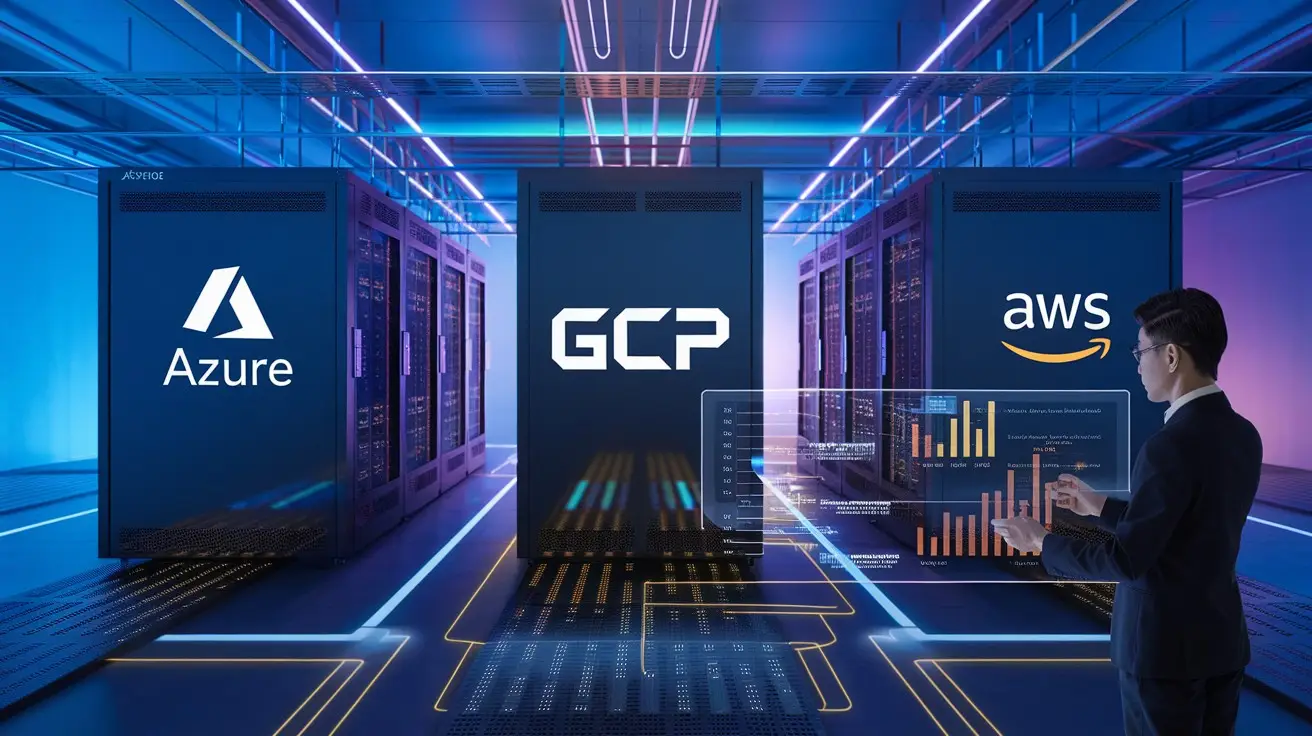
Ever spent $50,000 on a cloud platform only to realize six months later it’s completely wrong for your business? It happens more than you’d think. Tech leaders make million-dollar mistakes choosing between AWS, Azure, and GCP because they focus on flashy features instead of strategic fit.
Picking the right cloud provider isn’t just an IT decision—it’s a business strategy that affects everything from your development speed to your bottom line.
The key to choosing between cloud providers isn’t comparing endless feature lists. It’s understanding exactly how each platform aligns with your specific workloads, team skills, and business goals.
But here’s what nobody tells you: the “best” cloud provider doesn’t exist in a vacuum. What works brilliantly for Netflix might be a disaster for your fintech startup. And the reason why might surprise you…
Understanding Your Cloud Computing Needs

Understanding Your Cloud Computing Needs
Before diving into specific cloud providers, it’s essential to thoroughly understand what your organization actually needs from cloud computing. This foundational step will guide all subsequent decisions.
Assessing Workload Requirements
Start by cataloging your current and anticipated workloads:
Compute-intensive tasks: AI/ML processing, big data analytics
Storage-heavy applications: Media storage, databases, archives
Network-dependent services: Content delivery, streaming services
Specialized requirements: GPU acceleration, high-performance computing
Map each workload to determine which cloud services they’ll require, as different providers excel in different workload types.
Identifying Business Priorities
Define what matters most to your organization:
Speed to market: How quickly can you deploy and iterate?
Technology integration: Compatibility with existing systems
Geographic reach: Global presence vs. regional concentration
Vendor relationships: Existing partnerships or licensing agreements
Innovation focus: Access to cutting-edge vs. stable technologies
These priorities will help narrow your provider options based on strategic fit rather than just technical capabilities.
Evaluating Scalability Requirements
Consider your growth trajectory:
Anticipated growth rate: Gradual vs. rapid expansion needs
Elasticity needs: Handling predictable vs. unpredictable demand spikes
Resource provisioning: Automatic vs. manual scaling preferences
Global expansion plans: Future geographic deployment requirements
Cloud platforms differ significantly in how they handle scaling and in which regions they operate most efficiently.
Determining Budget Constraints
Establish clear financial parameters:
CapEx vs. OpEx preferences: Upfront vs. ongoing cost models
Cost predictability needs: Fixed vs. variable pricing importance
Optimization capabilities: Tools for monitoring and controlling spend
Long-term commitment capacity: Ability to commit to reserved instances
Different providers offer varying discount structures, commitment options, and cost management tools.
Analyzing Security and Compliance Needs
Identify your non-negotiable security and regulatory requirements:
Industry-specific regulations: HIPAA, GDPR, PCI DSS, etc.
Data sovereignty requirements: Where data must legally reside
Security certifications needed: FedRAMP, ISO, SOC compliance
Identity management: Authentication and authorization needs
Disaster recovery requirements: RPO/RTO objectives
Each cloud provider offers different security features, compliance certifications, and data residency options that must align with your requirements.
Comparing Core Services Across Providers

Comparing Core Services Across Providers
Compute capabilities and pricing models
Each cloud provider offers distinct compute services with unique pricing structures:
AWS provides EC2 instances with the broadest selection of instance types. Their pricing model includes on-demand, reserved instances (1-3 year commitments with up to 72% savings), spot instances (up to 90% discount for flexible workloads), and savings plans. AWS charges per second with a one-minute minimum.
Azure features Virtual Machines with specialized options for Windows workloads. Their pricing includes pay-as-you-go, reserved instances (1-3 year terms with up to 72% savings), and spot VMs. Azure offers unique hybrid benefits for organizations with existing Microsoft licenses, potentially reducing costs by up to 40%.
GCP offers Compute Engine with per-second billing and sustained use discounts that automatically apply to instances running for significant portions of the month. Their committed use discounts provide 20-70% savings for 1-3 year commitments without requiring upfront payment.
Storage options and data management
AWS provides S3 (object storage), EBS (block storage), EFS (file storage), and Glacier (archival). Their tiered storage classes optimize costs based on access frequency.
Azure offers Blob Storage (object), Azure Disk Storage (block), Azure Files (file), and Archive Storage. Their unique feature is the StorSimple service, which automatically tiers data between on-premises and
cloud storage.
GCP features Cloud Storage (object), Persistent Disk (block), and Filestore (file). Their storage classes include Standard, Nearline, Coldline, and Archive, with automatic class migration options to optimize costs.
Database services and performance
AWS leads with the broadest database portfolio: RDS for relational databases, DynamoDB for NoSQL, Neptune for graph databases, and specialized options like Timestream for time-series data.
Azure provides SQL Database (managed SQL Server), Cosmos DB (multi-model database with global distribution), and Table Storage. Their SQL Database offers unique integration with other Microsoft services.
GCP offers Cloud SQL, Cloud Spanner (globally distributed relational database), Bigtable (NoSQL), and Firestore. GCP’s Spanner stands out with its ability to combine relational database capabilities with horizontal scaling.
Networking features
AWS provides VPC, Direct Connect, Global Accelerator, and Route 53. Their Transit Gateway simplifies network architecture by connecting VPCs.
Azure offers Virtual Network, ExpressRoute, Content Delivery Network, and Traffic Manager. Their unique Virtual WAN service simplifies branch connectivity.
GCP features VPC, Cloud Interconnect, Cloud CDN, and Cloud DNS. Their Network Service Tiers allow customers to optimize for cost or performance, and their Andromeda virtualized networking stack delivers consistent performance.
Each provider continues to evolve these core services regularly, making it essential to evaluate them based on your specific workload requirements and cost considerations.
Azure: Microsoft’s Cloud Platform

Azure: Microsoft’s Cloud Platform
Microsoft Azure has established itself as a powerful cloud platform, especially appealing to organizations with existing Microsoft investments. Let’s explore what makes Azure a compelling option.
Strengths for Enterprise and Windows Environments
Azure excels in enterprise settings where Windows Server, Active Directory, and SQL Server are already deployed. The platform offers seamless compatibility with Windows-based applications and provides familiar management interfaces for IT teams accustomed to Microsoft technologies. For large enterprises, Azure provides robust governance tools, compliance certifications, and enterprise agreements that align with existing procurement processes.
Integration with Microsoft Ecosystem
One of Azure’s strongest selling points is its deep integration with Microsoft’s product suite. Organizations using Microsoft 365, Dynamics 365, or Power Platform will find native connectivity and simplified authentication. This integration extends to development tools as well, with excellent support for
.NET applications, Visual Studio, and GitHub. The cohesive experience across Microsoft products reduces friction for both developers and end-users.
Hybrid Cloud Capabilities
Azure Arc and Azure Stack represent Microsoft’s commitment to hybrid cloud deployments. Azure Arc extends Azure management to on-premises, multi-cloud, and edge environments, allowing consistent policy enforcement and deployment processes across environments. Azure Stack enables running Azure
services on-premises, ideal for organizations that need to maintain certain workloads locally due to compliance or latency requirements.
AI and Machine Learning Offerings
Microsoft has invested heavily in making AI accessible through Azure Cognitive Services, which provides pre-built APIs for vision, speech, language, and decision-making capabilities. Azure Machine Learning offers comprehensive tools for data scientists to build, train, and deploy models. For organizations looking to implement AI solutions without deep expertise, Azure’s AI Builder provides low-code options to incorporate intelligence into business processes.
Pricing Structure and Cost Management
Azure’s pricing model follows a consumption-based approach with options for reserved instances to reduce costs for predictable workloads. The Azure Hybrid Benefit allows organizations to apply existing on-premises Windows Server and SQL Server licenses to Azure, potentially reducing cloud costs by up to 40%. Azure Cost Management provides robust tools for monitoring, allocating, and optimizing cloud spending, with features like budget alerts, cost analysis, and advisor recommendations to identify potential savings.
Google Cloud Platform (GCP): Innovation-Focused

Google Cloud Platform (GCP): Innovation-Focused
Google Cloud Platform has established itself as an innovation-driven cloud provider, leveraging Google’s extensive experience in data processing, analytics, and machine learning. GCP offers unique advantages for businesses seeking cutting-edge technologies and robust performance.
Big Data and Analytics Advantages
GCP excels in big data solutions with its comprehensive suite of tools:
BigQuery: A serverless, highly scalable data warehouse that enables super-fast SQL queries using the processing power of Google’s infrastructure
Dataflow: A unified programming model and managed service for developing and executing data processing pipelines
Pub/Sub: A messaging service that allows for real-time data streaming and analytics
Dataproc: A managed Spark and Hadoop service that simplifies big data processing
GCP’s data analytics tools are designed to handle petabyte-scale data with impressive speed and cost efficiency, making them ideal for organizations with massive datasets or complex analytical requirements.
Machine Learning and AI Capabilities
Google’s leadership in AI translates directly to GCP’s offerings:
Vertex AI: Combines AutoML and AI Platform into a unified platform for building and deploying ML models
Vision AI, Speech-to-Text, and Natural Language API: Pre-trained models that provide immediate access to advanced AI capabilities
TensorFlow Enterprise: Optimized, supported, and scaled TensorFlow for cloud environments
These tools make GCP particularly attractive for businesses looking to incorporate AI into their products or leverage machine learning for business insights without extensive expertise.
Network Performance Benefits
GCP’s network infrastructure provides several distinct advantages:
Premium Tier Network: Routes traffic through Google’s private global network, reducing latency and improving reliability
Live Migration of VMs: Allows maintenance without downtime
Global Load Balancing: Distributes traffic across regions with a single anycast IP
Low Latency Connectivity: Optimized for global applications with consistent performance
This network architecture is especially beneficial for globally distributed applications requiring consistent performance.
Kubernetes and Container Orchestration
As the original creator of Kubernetes, Google offers exceptional container services:
Google Kubernetes Engine (GKE): A managed, production-ready environment for deploying containerized applications
Autopilot Mode: Fully managed Kubernetes experience with hands-off operations
GKE Enterprise: Multi-cluster management capabilities for complex deployments
Cloud Run: Serverless container deployment that abstracts infrastructure management entirely
GCP’s container services provide enterprise-grade security, scalability, and simplified operations for organizations embracing containerization and microservices architectures.
Amazon Web Services (AWS): Market Leader

Amazon Web Services (AWS): Market Leader
AWS stands as the pioneer in cloud computing, capturing the largest market share since its launch in 2006. This dominance stems from several key strengths that continue to make it a preferred choice for organizations worldwide.
Extensive Service Portfolio
AWS offers over 200 fully-featured services spanning computing, storage, databases, analytics, networking, mobile, developer tools, and more. This comprehensive catalog allows businesses to:
Build sophisticated applications with services like EC2, Lambda, and ECS
Store data across various formats with S3, EBS, EFS, and Glacier
Implement specialized solutions with AI/ML services like SageMaker and Rekognition
Deploy industry-specific tools for healthcare, financial services, and media industries
The breadth of AWS’s offerings means businesses rarely need to look elsewhere for cloud capabilities.
Global Infrastructure Reach
AWS boasts an unmatched global footprint with:
27+ geographic regions
87+ availability zones
410+ edge locations and Points of Presence
Presence in 245+ countries and territories
This extensive infrastructure allows organizations to deploy applications closer to end-users, ensuring lower latency and better performance while meeting regional compliance requirements.
Maturity and Reliability Factors
As the first major cloud provider, AWS has had time to refine its services:
Proven track record with 99.99% service availability for core services
Battle-tested infrastructure handling millions of concurrent customers
Established security practices with AWS Shield, WAF, and GuardDuty
Comprehensive compliance certifications (HIPAA, PCI DSS, FedRAMP, etc.)
This maturity translates to stable, reliable services that organizations can confidently build critical systems upon.
Ecosystem and Third-Party Integrations
AWS’s market leadership has created a vast ecosystem:
Thousands of technology partners offering pre-integrated solutions
Extensive AWS Marketplace with 10,000+ listings
Large community of AWS-certified professionals
Robust documentation, tutorials, and support resources
Active open-source community contributions
This ecosystem provides ready-made solutions for common business challenges and simplifies adoption.
Pricing Flexibility
AWS provides diverse pricing options to optimize costs:
Pay-as-you-go model with no upfront commitments
Reserved Instances for 1-3 year terms with up to 72% savings
Spot Instances for non-critical workloads at up to 90% discount
Savings Plans for flexible compute usage
Free tier for testing and small workloads
The AWS Cost Explorer and Trusted Advisor help identify cost optimization opportunities, while tools like AWS Organizations enable centralized billing across multiple accounts.
Decision Framework for Cloud Selection

Decision Framework for Cloud Selection
Selecting the right cloud provider requires a structured approach to evaluate your options against your organization’s unique needs. Here’s a comprehensive decision framework to guide your selection process:
Technical Compatibility Assessment
Begin by thoroughly analyzing your existing technology stack and applications to determine compatibility with potential cloud providers:
Application architecture: Assess whether your applications are cloud-ready or require refactoring
Programming languages and frameworks: Verify support for your development environment
Database systems: Evaluate native cloud database offerings against your current data solutions
Integration requirements: Identify APIs and services needed to connect with existing systems
Compliance requirements: Determine which providers meet your regulatory needs (HIPAA, GDPR, etc.)
Create a compatibility matrix scoring each provider on these technical requirements to identify the best
technical fit.
Total Cost of Ownership Calculator
Looking beyond the listed prices is crucial for accurate cost projection:
Compute resources: Calculate costs based on your specific instance needs and usage patterns
Data storage: Estimate both storage and data transfer costs
Network traffic: Account for ingress/egress charges which vary significantly between providers
Support plans: Factor in costs for required support levels
Reserved instances/commitments: Compare discounts for long-term commitments
Hidden costs: Consider extras like IP addresses, load balancers, and monitoring tools
Most providers offer TCO calculators, but create your own spreadsheet for more accurate comparisons across services.
Migration Path Planning
A successful cloud transition requires detailed planning:
Phased approach: Determine which applications to migrate first (typically non-critical workloads)
Migration tools: Evaluate each provider’s migration assistance services and tools
Downtime requirements: Plan for service interruptions during migration
Training needs: Assess skill gaps requiring training before, during, and after migration
Timeline development: Create realistic schedules with buffer periods for unexpected issues
Document this migration roadmap with clear milestones and responsibilities for each phase.
Vendor Lock-in Considerations
Evaluate the long-term implications of your cloud provider choice:
Proprietary services: Identify which provider-specific services might create dependencies
Data portability: Examine options for extracting your data if needed
API standardization: Assess which providers use standard APIs versus proprietary ones
Exit strategy: Develop a contingency plan for switching providers
Container strategy: Consider Kubernetes and containerization to increase portability
Cross-cloud management tools: Explore tools supporting multi-cloud deployments
The degree of acceptable lock-in often depends on your business needs and risk tolerance.
Multi-Cloud Strategies

Multi-Cloud Strategies
Many organizations are moving beyond the “single provider” approach to embrace multi-cloud strategies that leverage the strengths of different cloud platforms.
Benefits of using multiple providers
Avoiding vendor lock-in: Perhaps the most compelling reason for multi-cloud adoption is reducing dependency on a single vendor. This gives you negotiating power and flexibility to migrate workloads if pricing or terms become unfavorable.
Best-of-breed selection: Each cloud provider excels in different areas. AWS might be your go-to for extensive infrastructure services, while GCP could handle your AI/ML workloads, and Azure might integrate seamlessly with your existing Microsoft stack.
Geographic coverage: Different providers have varying strengths in certain regions. Using multiple clouds allows you to deploy applications closer to your users worldwide, minimizing latency and addressing data sovereignty requirements.
Disaster recovery: Multi-cloud architectures provide robust business continuity options, allowing you to failover between providers during outages or service disruptions.
Challenges of managing diverse environments
Increased complexity: Each provider has unique interfaces, APIs, and services, creating a steeper learning curve for development and operations teams.
Cost management: Tracking expenses across multiple platforms can be challenging, with different pricing models and billing structures to navigate.
Security consistency: Implementing uniform security policies and controls across diverse environments requires careful planning and specialized tools.
Skill requirements: Teams need broader knowledge spanning multiple platforms, which can impact hiring, training, and operational efficiency.
Tools for multi-cloud management
Cloud management platforms: Solutions like HashiCorp Terraform, Pulumi, and CloudFormation allow infrastructure-as-code deployment across providers using consistent syntax and workflows.
Kubernetes and containers: Container orchestration provides a consistent deployment model regardless of the underlying infrastructure, with managed Kubernetes services available on all major clouds.
Monitoring and observability tools: Platforms like Datadog, New Relic, and Dynatrace offer unified monitoring across cloud environments, providing centralized visibility.
Cost optimization services: Tools such as CloudHealth, Flexera, and CloudCheckr help track and optimize spending across multiple providers.
Security and compliance frameworks: Solutions like Prisma Cloud and Wiz provide consistent security posture management across diverse cloud environments.
While multi-cloud strategies offer significant advantages, they require careful planning and the right tooling to manage effectively. Organizations must weigh the benefits against the added complexity when determining if a multi-cloud approach aligns with their business objectives.
Making Your Final Decision

Making Your Final Decision
Choosing between Azure, GCP, and AWS represents a significant strategic decision for your organization. After exploring the strengths, weaknesses, and specific offerings of each cloud provider, it’s time to formalize your decision-making process. This methodical approach ensures you select the provider that best aligns with your organization’s unique needs and future trajectory.
Creating a Weighted Scoring Matrix
A weighted scoring matrix provides an objective framework for evaluating cloud providers against the criteria that matter most to your organization. This approach transforms subjective preferences into quantifiable data points.
Step 1: Identify Key Evaluation Criteria
Begin by listing all relevant factors for your decision, such as:
Cost structure and pricing models
Service availability in your regions
Security and compliance capabilities
Performance benchmarks
Integration with existing systems
Available managed services
Developer experience and tooling
Support quality and availability
Ecosystem and marketplace offerings
Specialized services (AI/ML, IoT, etc.)
Step 2: Assign Weights to Each Criterion
Not all factors carry equal importance. Distribute 100 points across your criteria based on their relative importance to your organization. For example:
| Criterion | Weight (%) |
| Cost efficiency | 20 |
| Security features | 25 |
| Service availability | 15 |
| Performance | 15 |
| Integration capabilities | 10 |
| Support quality | 10 |
| Developer experience | 5 |
Step 3: Rate Each Provider
For each criterion, rate each provider on a consistent scale (typically 1-5 or 1-10), where higher numbers indicate better performance:
| Criterion | Weight | AWS (1-5) | Azure (1-5) | GCP (1-5) |
| Cost efficiency | 20 | 3 | 4 | 4 |
| Security features | 25 | 5 | 4 | 4 |
| Service availability | 15 | 5 | 4 | 3 |
| Performance | 15 | 4 | 4 | 5 |
| Integration capabilities | 10 | 4 | 5 | 3 |
| Support quality | 10 | 4 | 4 | 3 |
| Developer experience | 5 | 4 | 3 | 5 |
Step 4: Calculate Weighted Scores
Multiply each rating by its corresponding weight, then sum the results for each provider:
AWS score = (3×20) + (5×25) + (5×15) + (4×15) + (4×10) + (4×10) + (4×5) = 420
Azure score = (4×20) + (4×25) + (4×15) + (4×15) + (5×10) + (4×10) + (3×5) =
410
GCP score = (4×20) + (4×25) + (3×15) + (5×15) + (3×10) + (3×10) + (5×5) = 380
This quantitative approach helps identify the provider that best matches your weighted priorities, though it shouldn’t be the sole determinant of your decision.
Proof of Concept Testing Methodology
While scoring matrices provide theoretical comparisons, hands-on testing delivers practical insights into how each cloud platform performs with your specific workloads.
Define Clear Testing Objectives
Establish specific, measurable goals for your proof of concept (PoC):
Performance benchmarks under specified loads
Integration capabilities with existing systems
Developer productivity metrics
Cost accumulation for representative workloads
Security implementation effectiveness
Backup and disaster recovery validation
Select Representative Workloads
Choose workloads that reflect your actual production scenarios:
A compute-intensive application component
A data-processing pipeline
A customer-facing application with authentication
A typical storage and retrieval operation
An integration point with on-premises systems
Establish Testing Parameters
Define consistent testing conditions across providers:
Equivalent virtual machine configurations
Similar network topologies
Comparable storage performance tiers
Identical data sets for processing
Standardized security configurations
Create Evaluation Rubrics
Develop detailed rubrics for qualitative assessments:
Ease of deployment (1-10 scale)
Quality of documentation (1-10 scale)
Troubleshooting experience (1-10 scale)
Management portal usability (1-10 scale)
API and SDK quality (1-10 scale)
Implementation Timeline
Structure your PoC with clear phases:
- Planning (1-2 weeks): Define test scenarios, prepare testing scripts, establish baselines
- Configuration (1 week per provider): Set up environments on each platform
- Testing (2-4 weeks per provider): Run workloads, collect performance data
- Analysis (1-2 weeks): Compare results, document findings
- Recommendation (1 week): Prepare final recommendation based on objective results
This methodical approach prevents confirmation bias and ensures decisions are based on actual performance rather than marketing claims or preconceptions.
Considering Future Growth Requirements
Cloud provider selection isn’t just about meeting today’s needs—it must accommodate your organization’s growth trajectory and evolving technological landscape.
Scalability Projections
Map your anticipated growth across multiple dimensions:
User base expansion: How will authentication and concurrent session needs evolve?
Data volume growth: What storage requirements will you face in 3-5 years?
Geographic expansion: Which new regions will you need to serve?
Transaction volume increases: How will your compute requirements scale?
Emerging Technology Adoption
Assess each provider’s investment and capabilities in technologies you may need:
Artificial intelligence and machine learning capabilities
Edge computing infrastructure and services
Quantum computing research and implementations
Blockchain services and infrastructure
IoT platform maturity and device management
AR/VR support and rendering services
Architectural Evolution
Consider how your application architecture might evolve:
From monolithic to microservices
From virtual machines to containers to serverless
From relational databases to NoSQL or multi-model databases
From traditional CI/CD to GitOps and infrastructure as code
From manual operations to SRE and auto-remediation
Industry-Specific Roadmaps
Evaluate each provider’s commitment to your industry:
Healthcare: HIPAA compliance, medical imaging, healthcare APIs
Financial services: Payment processing, fraud detection, regulatory compliance
Retail: Inventory management, personalization engines, omnichannel experiences
Manufacturing: Digital twins, supply chain optimization, IoT integration
Media: Content delivery, transcoding, audience analytics
Budget Projections
Model future cloud spending under different growth scenarios:
Baseline growth: 20-30% year-over-year increase in resources
Accelerated growth: 50-100% year-over-year increase
Geographic expansion: New region deployment costs
Architectural shifts: Transition costs between deployment models
A provider that excels for your current needs but lacks the capabilities to support your future direction could result in costly migrations later.
Evaluating Provider Support and SLAs
The technical capabilities of cloud platforms are only part of the equation. The support structure and service guarantees can significantly impact your operational success.
Support Tier Comparison
Analyze the support packages available from each provider:
| Support Feature | AWS | Azure | GCP |
| Basic tier cost | Free (limited) | Free (limited) | Free (limited) |
| Business tier cost | ~$100/month + % of spend | ~$100/month + % of spend | ~$100/month + % of spend |
| Enterprise tier cost | ~$15,000/month + % of spend | Custom negotiated | Custom negotiated |
| Response time (critical issues) | 15 min – 1 hour (depends on tier) | 15 min – 1 hour (depends on tier) | 15 min – 1 hour (depends on tier) |
| Technical account manager | Enterprise only | Enterprise only | Enterprise only |
| Support Feature | AWS | Azure | GCP |
| Support channels | Email, chat, phone | Email, chat, phone | Email, chat, phone |
| 24/7 availability | Business tier+ | Business tier+ | Business tier+ |
SLA Analysis
Compare service level agreements for critical services:
| Service Type | AWS SLA | Azure SLA | GCP SLA |
| Compute (VM uptime) | 99.99% | 99.9% – 99.99% | 99.5% – 99.9% |
| Managed databases | 99.95% – 99.999% | 99.95% – 99.995% | 99.95% – 99.999% |
| Object storage | 99.9% – 99.999% | 99.9% – 99.99% | 99.9% – 99.95% |
| Content delivery | 99.9% | 99.9% | 99.9% |
| DNS services | 100% | 100% | 100% |
SLA Financial Impact
Calculate the business cost of downtime against SLA guarantees:
- Determine hourly revenue impact of service unavailability
- Calculate expected downtime hours based on SLA percentage:
99.9% availability = 8.76 hours downtime per year
99.99% availability = 52.56 minutes downtime per year
99.999% availability = 5.26 minutes downtime per year
- Multiply hourly revenue impact by expected downtime
- Compare against the cost difference between SLA tiers
Support Experience Assessment
Research actual support experiences from multiple sources:
Third-party review sites
Industry forums and communities
Direct conversations with existing customers
Trial support interactions during PoC
Support during critical incidents (historical reports)
Documentation Quality
Evaluate the comprehensiveness and clarity of documentation:
Beginner-friendly onboarding guides
Advanced troubleshooting resources
Well-documented APIs with examples
Community contribution to documentation
Multi-format availability (text, video, interactive)
Regular updates reflecting service changes
Community Support Ecosystem
Assess the breadth and depth of community resources:
Stack Overflow question volume and answer quality
GitHub repositories with examples and tools
Third-party training availability
Active user groups and meetups
Professional certification programs
Annual conferences and technical events
Remember that even the most reliable cloud services will experience issues. The quality of support during those critical moments often determines whether an incident becomes a minor inconvenience or a major business disruption.
By methodically working through these four approaches—weighted scoring, proof of concept testing, future growth assessment, and support evaluation—you’ll arrive at a decision based on comprehensive analysis rather than intuition or vendor pressure. The right cloud provider for your organization emerges from this balanced consideration of current requirements, future needs, objective testing, and real-world support quality.

Selecting the right cloud provider requires a strategic approach focused on your organization’s specific needs, technical requirements, and long-term objectives. Whether you choose Microsoft Azure for its seamless integration with existing Microsoft products, Google Cloud Platform for its innovative data analytics and machine learning capabilities, or AWS for its mature ecosystem and extensive service offerings, your decision should align with your unique business priorities. Multi-cloud strategies may also provide flexibility and avoid vendor lock-in, though they introduce additional complexity.
Remember that cloud adoption is a journey, not a destination. As your organization evolves, so too might your cloud strategy. Begin with a thorough assessment of your current and future needs, consider piloting potential solutions with proof-of-concept projects, and regularly evaluate your chosen provider’s performance against your business requirements. By taking a methodical approach to cloud provider selection, you’ll position your organization for scalable, secure, and cost-effective growth in the digital landscape.

Good Content . Really Helpful